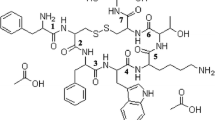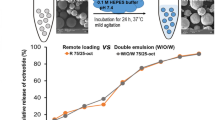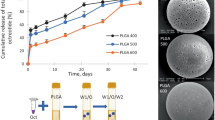Abstract
Purpose. Poly(lactic acid) (PLA) and poly(lactic-co-glycolic acid) (PLGA) microspheres were investigated concerning the possible acylation of incorporated peptides.
Methods. Atrial natriuretic peptide (ANP) and salmon calcitonin (sCT) were encapsulated into PLA and PLGA microspheres. Peptide integrity was monitored by HPLC-MS analysis during microsphere degradation for four weeks. sCT fragmentation with endoproteinase Glu-C was used for identifying modified amino acids. Peptide stability in lactic acid solutions was investigated to elucidate possible mechanisms for preventing peptide acylation.
Results. Both peptides were acylated by lactic and glycolic acid units inside degrading microspheres in a time-dependent manner. After 21 days, 60% ANP and 7% sCT inside PLA microspheres were acylated. Fragmentation of sCT with endoproteinase Glu-C revealed that besides the N-terminal amine group, lysine, tyrosine or serine are further possible targets to acylation. Stability studies of the peptides in lactic acid solutions suggest that oligomers are the major acylation source and that lower oligomer concentration and higher pH substantially decreased the reaction velocity.
Conclusions. The use of PLA and PLGA for drug delivery needs substantially more circumspection. As, according to FDA standards, the potential hazards of peptide acylation products need to be assessed, our findings may have significant implications for products already on the market. Techniques to minimize the acylation reaction are suggested.
Similar content being viewed by others
REFERENCES
D. Bailey, E. Zanders, and P. Dean. The end of the beginning for genomic medicine. Nature Biotechnology 19:207–209 (2001).
R. Langer. New methods of drug delivery. Science 249:1527–1533 (1990).
H. Okada. One-and three-month release injectable microspheres of the LH-RH superagonist leuprorelin acetate. Adv. Drug Deliv. Rev. 28:43–70 (1997).
P. J. Camarata, R. Suryanarayanan, D. A. Turner, R. G. Parker, and T. J. Ebner. Sustained release of nerve growth factor from biodegradable polymer microspheres. Neurosurgery 30:313–319 (1992).
S. D. Putney and P. A. Burke. Improving protein therapeutics with sustained-release formulations. Nat. Biotechnol. 16:153–157 (1998).
S. P. Schwendeman, M. Cardamone, M. R. Brandon, A. Klibanov, and R. Langer. Stability of proteins and their delivery from biodegradable polymer microspheres. In S. Cohen and H. Bernstein (eds.), Microparticulate Systems for the Delivery of Proteins and Vaccines, Marcel Dekker, New York, 1996 pp. 1–49.
J. L. Cleland, A. Mac, B. Boyd, J. Yang, E. T. Duenas, D. Yeung, D. Brooks, C. Hsu, H. Chu, V. Mukku, and A. J. Jones. The stability of recombinant human growth hormone in poly(lacticco-glycolic acid) (PLGA) microspheres. Pharm. Res. 14:420–425 (1997).
J. E. Babensee, L. V. McIntire, and A. G. Mikos. Growth factor delivery for tissue engineering. Pharm. Res. 17:497–504 (2000).
K. Y. Lee, M. C. Peters, K. W. Anderson, and D. J. Mooney. Controlled growth factor release from synthetic extracellular matrices. Nature 408:998–1000 (2001).
W. M. Saltzman. Growth factor delivery in Tissue Engineering. MRS Bulletin 21:62–65 (1996).
R. T. Bartus, M. A. Tracy, D. F. Emerich, and S. E. Zale. Sustained delivery of proteins for novel therapeutic drugs. Science 281:1161–1162 (1998).
W. R. Gombotz and D. K. Pettit. Biodegradable polymers for protein and peptide drug delivery. Bioconjug. Chem. 6:332–351 (1995).
S. Cohen and H. Bernstein. Microparticulate Systems for the Delivery of Proteins and Vaccines, Marcel Dekker, New York, 1996.
S. P. Baldwin and W. M. Saltzman. Materials for protein delivery in tissue engineering. Adv. Drug Deliv. Rev. 33:71–86 (1998).
M. van de Weert, W. E. Hennink, and W. Jiskoot. Protein instability in poly(lactic-co-glycolic acid) microparticles. Pharm. Res. 17:1159–1167 (2000).
A. Brunner, K. Mäder, and A. Göpferich. pH and osmotic pressure inside biodegradable microspheres during erosion. Pharm. Res. 16:847–853 (1999).
G. Zhu, S. R. Mallery, and S. P. Schwendeman. Stabilization of proteins encapsulated in injectable poly(lactide-co-glycolide). Nature Biotechnology 18:52–57 (2000).
A. J. Domb, L. Turovsky, and R. Nudelman. Chemical interactions between drugs containing reactive amines with hydrolyzable insoluble biopolymers in aqueous solutions. Pharm. Res. 11: 865–868 (1994).
S. A. Kidwai, A. A. Ansari, and A. Salahuddin. Effect of succinylation (3-carboxypropionylation) on the conformation and immunological activity of ovalbumin. Biochem. J. 155:171–180 (1976).
M. A. Qasim and A. Salahuddin. Changes in conformation and immunological activity of ovalbumin during its modification with different acid anhydrides. Biochim. Biophys. Acta 536:50–63 (1978).
S. Murase, N. Yumoto, M. G. Petukhov, and S. Yoshikawa. Acylation of the alpha-amino group in neuropeptide Y(12-36) increases binding affinity for the Y2 receptor. J. Biochem. Tokyo 119:37–41 (1996).
S. P. Schwendeman, H. R. Costantino, R. K. Gupta, M. Tobio, A. C. Chang, M. J. Alonso, G. R. Siber, and R. Langer. Strategies for stabilising tetanus toxoid towards the development of a single-dose tetanus vaccine. Dev. Biol. Stand. 87:293–306 (1996).
C. Holten, A. Müller, and D. Rehbinder. Lactic acid: properties and chemistry of lactic acid and derivatives, Verlag Chemie, Weinheim, 1971.
S. Calis, R. Jeyanthi, T. Tsai, R. C. Mehta, and P. P. DeLuca. Adsorption of salmon calcitonin to PLGA microspheres. Pharm. Res. 12:1072–1076 (1995).
A. Göpferich. Polymer bulk erosion. Macromolecules 39:2598–2604 (1997).
F. von Burkersroda, L. Schedl, and A. Göpferich. Why degradable polymers undergo surface erosion or bulk erosion. Biomaterials submitted (2001).
A. Göpferich. Polymer bulk erosion. Macromolecules 39:2598–2604 (1997).
W. Jiang and S. P. Schwendeman. Stabilization and controlled release of bovine serum albumin encapsulated in poly(D,L-lactide) and poly(ethylene glycol) microsphere blends. Pharm. Res. 18:878–885 (2001).
S. J. De Jong, E. R. Arias, D. T. S. Rijkers, C. F. Van Nostrum, J. J. Kettenes-Van den Bosch, and W. E. Hennink. New insights into the hydrolytic degradation of poly(lactic acid): participation of the alcohol terminus. Polymer 42:2795–2802 (2001).
R. P. Haugland. Handbook of fluorescent probes and research chemicals, Molecular Probes Inc., Eugene, Oregon, USA, 1996.
Author information
Authors and Affiliations
Corresponding author
Rights and permissions
About this article
Cite this article
Lucke, A., Kiermaier, J. & Göpferich, A. Peptide Acylation by Poly(α-Hydroxy Esters). Pharm Res 19, 175–181 (2002). https://doi.org/10.1023/A:1014272816454
Issue Date:
DOI: https://doi.org/10.1023/A:1014272816454




